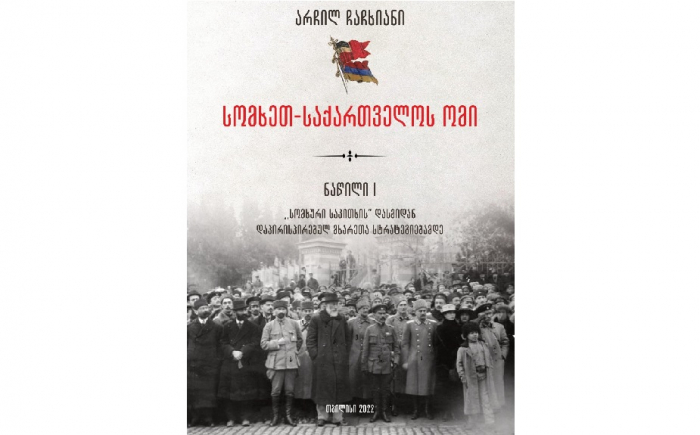10.10.23 21:15

Part 4
The historian Shota Vadachkoria provides us with the following statistical material on the dynamics of Armenian settlement in the territories of Georgia in the XIX century: "In 1804, the number of Armenians who settled in Tbilisi from the Yerevan Khanate was 2000 people. In 1807-1808, 338 Armenian families (1906 people) were resettled in the Tbilisi province and Avlabar, and in 1809-1811, under the chief ruler Tormasov, 428 families (2140 people) from Karabakh were resettled in Bolnisi. In 1829, 14,000 families were resettled from the provinces of Kars, Arzrum and Bayazet.
Taking into account the resettlement of Armenians in Georgia with the help of Russia, the dynamic process of their increase gives the following picture: in 1865 122.6 thousand Armenians lived in Georgia, in 1880. - In 1897 - up to 197.0 thousand Armenians. In 1897-1902 55 thousand Armenians were resettled in Georgia. As a result of these processes, the number of Armenians in Tbilisi increased from 46.7 thousand to 124.9 thousand, including 68 thousand newcomers...
The Russian scientist and researcher Nikolai Nikolayevich Shavrov, in his analytical work "A New Threat to the Russian Business in Transcaucasia: the Imminent Sale of Mugan to Foreigners", published in 1911, writes about the emigration of Armenians to Transcaucasia:
"After the end of the war of 1826-1828, in two years, from 1828 to 1930, we resettled more than 40,000 Armenian refugees from Persia and 84,000 from Turkey in Transcaucasia and provided them with the best state lands in the provinces of Elizavetpol and Erivan, where the number of Armenians was also insignificant, as in the province of Tiflis - Borchala, Akhaltsikh and Akhalkalak districts. There, more than 200 thousand dessiatinas of state land were allocated to them, and private land worth more than 2 million manats was bought from Muslims. It should be noted that in addition to the 124,000 Armenians who were officially resettled, a large number were unofficially resettled. Thus, the total number of emigrants was well over 200 thousand.
Thus, today (20th century), out of 1,300,000 Armenians living in Transcaucasia, more than 1,000,000 souls do not belong to the local population, and they were settled in this area by us".
According to the first general census of the Russian Empire in 1897, Armenians made up 29.53 per cent of the population of Tbilisi and Georgians only 26.44 per cent.
Another Russian writer, Vasily Velichko, writes about the same events: "Sometimes Georgians and Karabakh Muslims in the Caucasus smile sincerely and say that as soon as the Russian government withdraws its troops from Transcaucasia, not a single Armenian will be left here. But these words have been far from the truth for thirty years. Firstly, the Armenians have not only economically enslaved everyone else, but have also partially absorbed the political tendencies of other isolated peoples; finally, they already have their own "army" - the mob that came from Turkey. The ethnographic picture of Tbilisi has changed considerably in recent years. For example, it is now difficult to find the once very famous and attractive type of worker - the Georgian worker-razi: now they all have an unusually thuggish look and expression, they are wrapped in Turkish dolbands and bashlykas. The persecution of ordinary people, Russians and Georgians, is carried out by the city government".
Stephen Jones provides us with some interesting information about the peaceful expansion and use of Georgian territory by Armenians in the nineteenth and twentieth centuries: "The mass migration of Armenians to Georgia began in the nineteenth century during Russo-Turkish rule in 1828-1829, 1877-1878 and in the 1890s, when Armenian refugees were allowed to settle in Meskheti-Javakheti, Trialeti, Tbilisi and the Black Sea coast of Georgia around Sukhumi and Batumi, from where much of the local Muslim population had migrated to Ottoman lands during the 1828-1829 war. "
Towards the end of the twentieth century, the wealth gap between Armenians and Georgians became even more pronounced. Stephen Jones, for example, based on the accounts of the same Luigi Villari, paints a picture of the social prosperity experienced by Armenians in Georgia, and particularly in Tbilisi, at the beginning of the twentieth century:
This increases the importance and prestige of the Armenians, who feel that they are the masters of the place and, as the "chosen people", are even convinced that this is the way it should be.
It should be noted that even in the province of Yerevan, Armenians did not constitute an absolute majority of the provincial population, according to data from 1906.
From the book "The Armenian-Georgian War" by Archil Chachkhiani
To be continued
Read: 181
Write comment
(In their comments, readers should avoid expressing religious, racial and national discrimination, not use offensive and derogatory expressions, as well as appeals that are contrary to the law)
News feed
-
The struggle of two empires for Georgia - the heat of events is only accelerating
20:4904.05.24
-
Georgian Parliament holds yellow security level
12:0903.05.24
-
18:0002.05.24
-
Georgian Parliament Speaker, EU official review cooperation, integration
17:3202.05.24
-
US State Department condemns foreign influence bill advanced in Georgian Parliament
16:4002.05.24
-
Georgian Economy, Finance Minister review cooperation, projects with World Bank Executive Director
16:0002.05.24
-
15:0502.05.24
-
14:2902.05.24
-
13:5202.05.24
-
Austrian Airlines launches Vienna-Tbilisi flights
13:0002.05.24
-
12:1002.05.24
-
Health Ministry: Eight hospitalized during protest, patients' health conditions are satisfactory
11:2202.05.24
-
Ursula von der Leyen: Georgian people want European future for their country
10:1602.05.24
-
Is Echmiadzin opposed to peace in the South Caucasus? Once again...
18:5701.05.24
-
Georgian Parliament official highlights “threats” of external interference among “European public”
18:0001.05.24
-
17:0801.05.24
-
16:2701.05.24
-
15:2701.05.24
-
Josep Borrell Responds To The Situation In Georgia
14:4301.05.24
-
Tbilisi Mayor says Europe needs worthy, strong states
14:0001.05.24
-
Georgia imported 265 tons of lentils in January-March
13:3101.05.24
-
12:5001.05.24
-
12:0501.05.24
-
11:3101.05.24
-
10:5001.05.24
-
Yellow level of security regime to be again in effect in Parliament today
10:1601.05.24
-
Armenians in the Ottoman Empire: What Was, What Could Have Been and Today's Reality
7:5501.05.24
-
18:0530.04.24
-
Vice-President of the European Commission: I advised Ilia Darchiashvili to review our directive
17:1030.04.24
-
The Parliament elected Giorgi Kalandarishvili to the post of CEC Chairman
16:1530.04.24
-
15:4030.04.24
-
According to the government's decree, May 7, 8, and 10 were declared public holidays
13:5930.04.24
-
13:2130.04.24
-
Geostat: Georgia's economy grew by 8.2% in March
12:5030.04.24
-
President: Today, some people want to portray our 30-year-old allies and partners
12:0530.04.24
-
Georgian PM says “no alternative” to opening EU accession talks with country this year
11:3230.04.24


